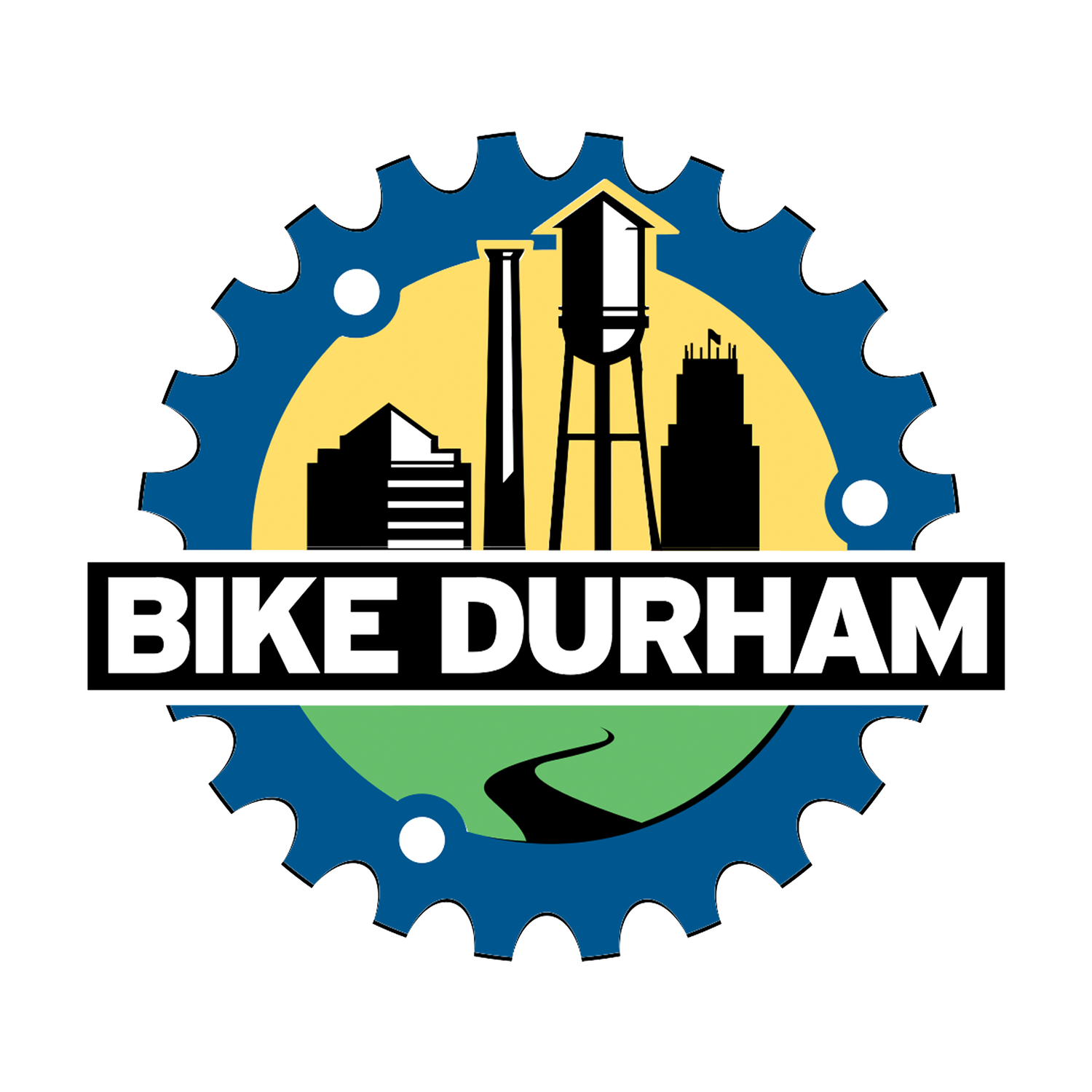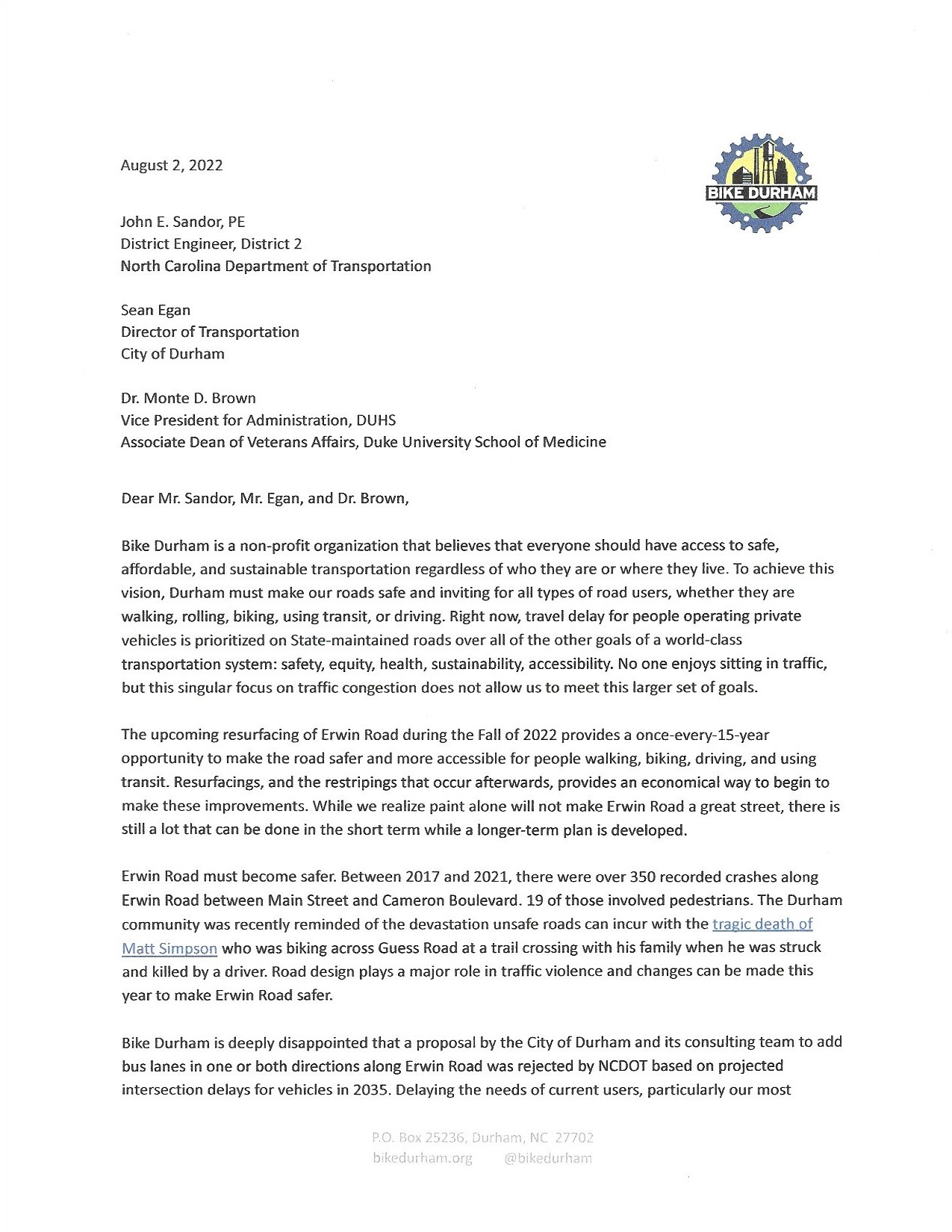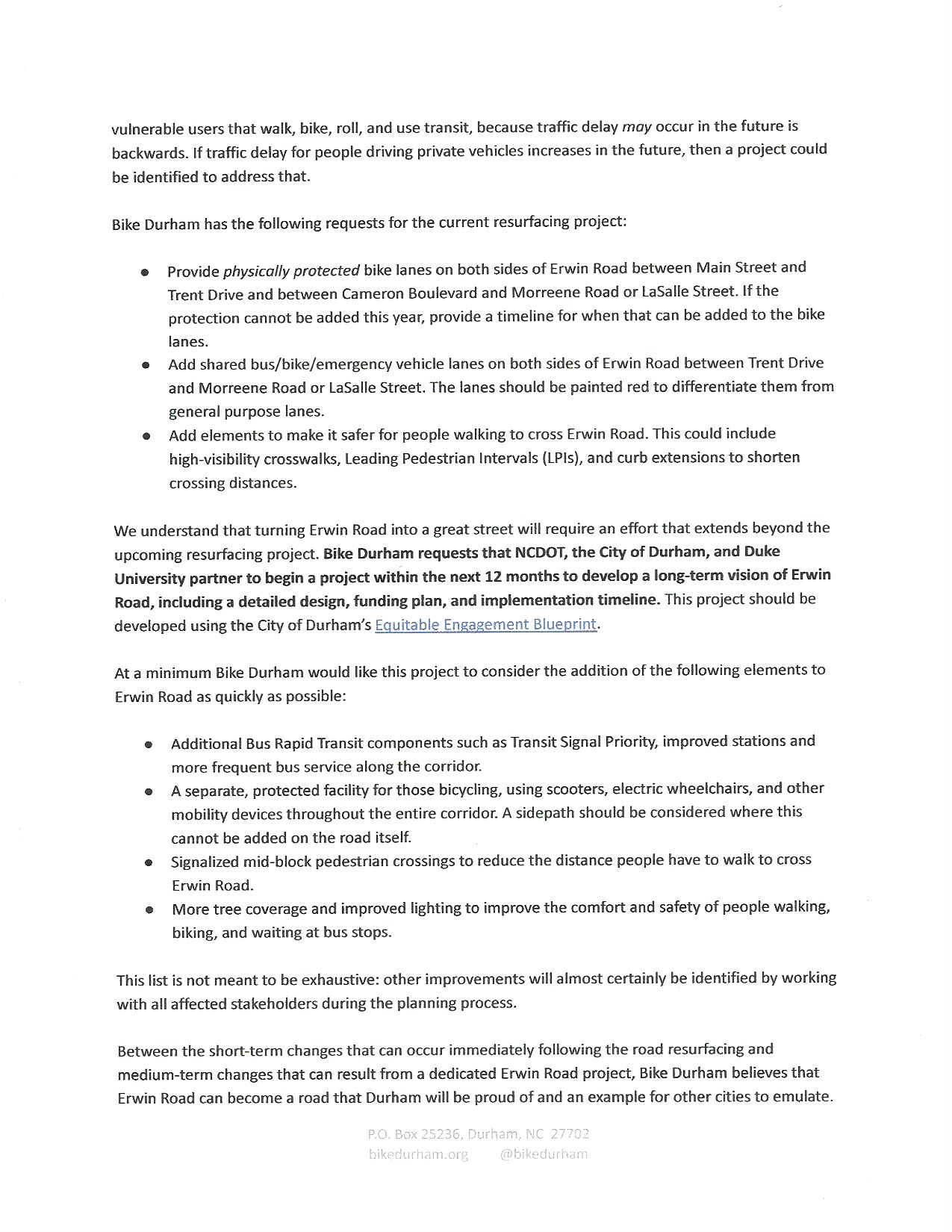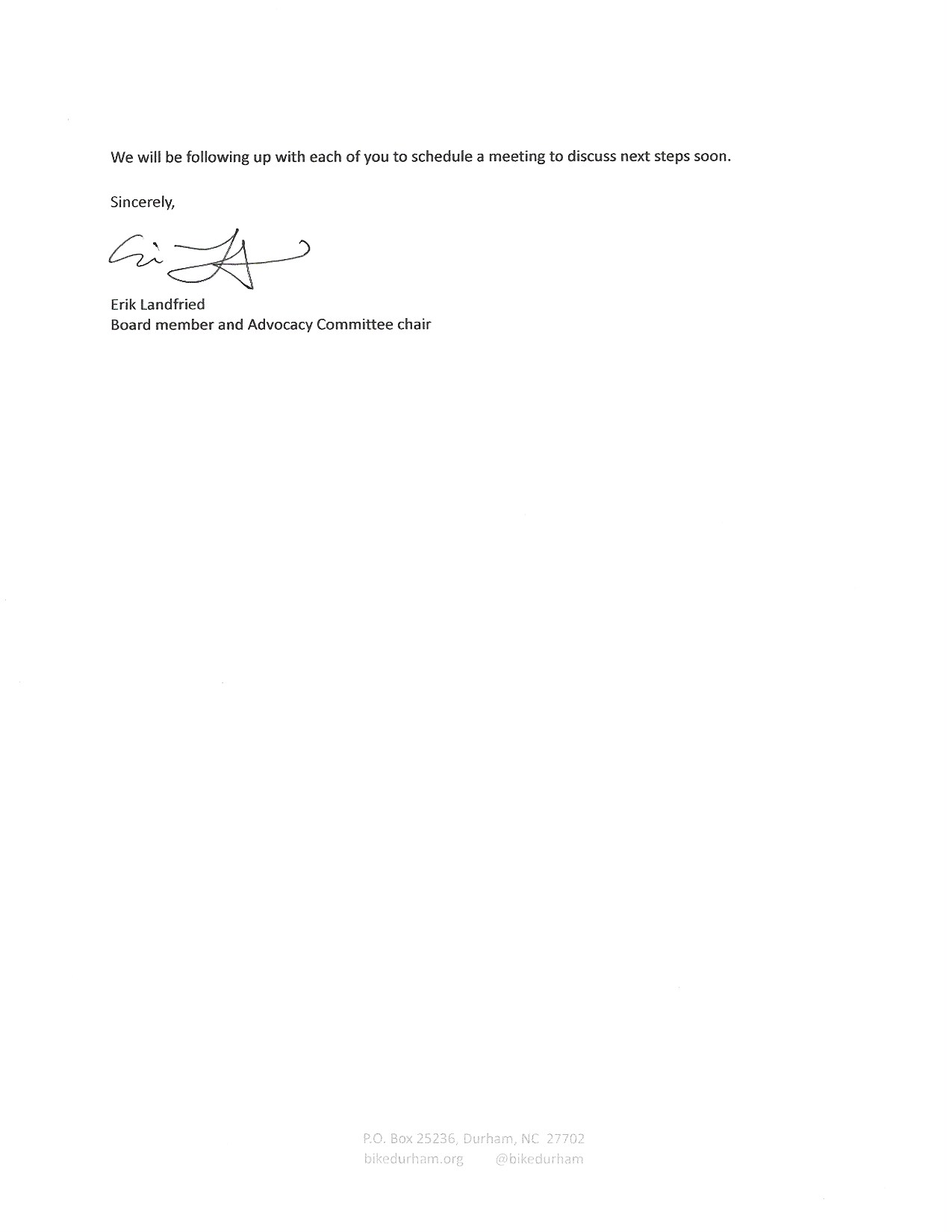Today, February 4th is Transit Equity Day in the U.S., named in memory of Rosa Parks on her birthday. When Rosa Parks refused to yield her seat in the Whites Only section of a Montgomery bus in 1958, she sparked a 381-day boycott of the bus system, demanding equal treatment. Today, public transit is an essential service in a transportation system that is still inequitable. Access to reliable transportation is closely linked to educational and economic opportunity, and in regions like the Triangle, that means access to a private automobile.
In order to achieve a transportation system that provides equitable access for everyone, while also eliminating carbon emissions and traffic deaths or serious injuries, we are going to have to make the public transit system work better for today’s customers. We have been advocating for this through the Durham County Transit Plan since 2020. This is the plan that establishes how $1.1 billion will be spent on public transit in Durham over the next 17 years (until 2040). The final draft plan was released in December and the County, the regional planning organization (DCHC MPO), and GoTriangle are soliciting comments on the plan now. This will be the topic of our next Community Meeting on February 27.
Through the Transit Equity Campaign, we have been successful at getting the public agencies to invest in authentic community engagement, and to put the needs of current transit riders at the front of the plan. More than $800 million (74%) of the recommended investments accomplish those goals. These investments include increasing bus service frequency, running service later on weekends, and new crosstown routes that will shorten travel times. It will speed up the construction of bus stop shelters and safe access to those stops, invest in improvements to the speed and reliability of bus services, and study the possibility of bringing Bus Rapid Transit to Durham. The Plan also funds a study of the needs of the paratransit service for those whose disability keeps them from using the bus; the costs of paying increased wages to operate and maintain a growing transit system; and provides staff resources to increase the accountability for whether these dollars are being spent effectively.
This is Not Enough
This is an important start on transforming our public transit system to one that creates more opportunities for riders as we make a transition to a clean, safe transportation system for everyone. However, it is not enough. For all the investments recommended in improving our bus systems, other improvements are left out:
The plan leaves many critical bus routes unfunded (listed on page 107 of recommended plan), meaning that travel times will remain too long and services will remain too infrequent for too many people.
The plan doesn’t show a commitment to electrifying the entire bus fleet.
The plan does not make a commitment to keep zero fares.
The plan does not show how sidewalk connections, or the Better Bus Project recommendations on Holloway and Fayetteville Streets and other locations throughout the city, will be fully funded.
Finally, the plan does not show a viable option for how riders will experience fast, reliable, and frequent regional transit service between Durham and opportunities in RTP, Cary, and Raleigh, or Chapel Hill.
The Commuter Rail is Not Viable in Durham Today
Bike Durham is strongly supportive of fast, reliable, and frequent regional transit services between Durham and opportunities in RTP, Cary, and Raleigh. And we understand the desire to bring rail service to the Triangle. However, the Commuter Rail project that has been studied would not be reliable or frequent because it would only offer two trips in the middle of the day, two trips at night, and no service on weekends. This would not be useful for people who work jobs other than 9-to-5'ers, nor for getting to cultural or entertainment opportunities. We are disappointed that options for frequent all-day, all-week service have not been studied to this point in tim
GoTriangle has only been studying rail service in the existing rail corridor, and that is limited to what the North Carolina Railroad and Norfolk-Southern Railway will allow. At this point in time, these entities have not even agreed to participate in an evaluation of the feasibility of frequent, all-day service in the corridor. This is why GoTriangle has only been evaluating Commuter Rail service levels (eight trips in the morning, two in the middle of the day, eight in the afternoon, and two at night - weekdays only). They have recently presented the results of their Commuter Rail Feasibility Study and are also soliciting public comments right now.
The project is estimated to cost $3.2 billion and carry about 12,000 daily person trips by 2040. At this cost and this level of ridership, GoTriangle has determined that the project is unlikely to be eligible for the Federal funding source that often pays about 50% of major project costs. The Durham segment of the corridor between RTP and West Durham is estimated to cost about $1.6 billion due to the need for an additional set of tracks and complicated designs for the east Durham railyard and several street crossings. The draft final Durham County Transit Plan recommends reserving 26% of the revenues through 2040 for a regional connection, or about $290 million. That leaves a BIG gap - upwards of $1.3 billion - to build a project that doesn’t even have the service levels that we need. Until Durham and Wake have new robust local transit tax options available to build the full project and operate frequent service, this rail project in Durham is not viable.
Wake County has a stronger tax base and could afford to build either the leg from Garner to downtown Raleigh, or from downtown Raleigh to RTP without Federal funding. If Wake County is inclined to commit money to the central segment, Durham leaders should not be seduced into spending any transit tax revenues to extend the service beyond RTP until we can fully fund a frequent connection all the way to West Durham.
Here’s why:
It would not provide any new access benefits for current riders or those using transit to access the opportunities east of RTP. For the foreseeable future, an Ellis Road station would be predominantly a park-and-ride location, not a walk-to-transit location. Current riders going to opportunities east of RTP would still make bus connections at an RTP station since GoTriangle would not relocate their regional transit center to Ellis Road.
It would consume most, if not all, of the $290 million recommended to be reserved for regional transit connections in the draft final Durham County Transit Plan. We still would need to raise more than $1.3 billion in order to build out a fast, frequent, and reliable regional transit connection from east Durham, downtown Durham, and west Durham.
GoTriangle’s evaluation is that there is a significant level of risk that the project might ever get completed. In order to build and operate the studied service, GoTriangle would need agreement from North Carolina Railroad, Norfolk Southern Railway, CSX Railway, and Amtrak. These negotiations usually take years, are unpredictable, and sometimes fail. Charlotte thought they had an agreement with Norfolk Southern to purchase a corridor for the proposed Red Line project, when Norfolk Southern changed their mind. That was in 2013.
There are other, feasible opportunities to provide fast, frequent, and reliable transit service to key regional destinations that can be accessed from more parts of Durham.
Graphic rendering of a Bus Rapid Transit station.
Another Path to Regional Transit Connections
Though a rail connection is not viable for Durham at this point in time, we must still find solutions to improve regional transit connections between Durham, RTP, Cary, and Raleigh, or Chapel Hill. As housing prices rise in Durham, demand is growing for connections to other communities like Butner, or Graham, or even Oxford. Bus connections should be pursued now that increase the frequency of express service to downtown Raleigh and to Chapel Hill. We should be studying investments that make it possible for these buses to bypass traffic with wider freeway shoulders, priority at traffic signals, and bus only ramps for easy on-off at key stops. We should also be studying high quality bus rapid transit services where buses have dedicated lanes and stops that are similar to rail stations. This can be a progression of steps over time that starts now and improves as our communities are ready and can afford them.
Our local leaders throughout the region should also begin working with their counterparts throughout the state on building support for greater funding options for transit. We can only achieve our vision for excellent transit with more local and state revenues.
Our recommendations
For Durham’s elected leadership:
Durham leaders should support Wake County in their decision about whether to pursue one of the two eastern segments with Wake County funds, but they should not support spending Durham transit tax revenues on this project.
Durham staff should pursue state and federal funding for projects that would make at-grade crossings and rail bridges safer for everyone in Durham and make it less expensive to pursue a regional rail project in the future.
Durham, and the region, should evaluate transit service and infrastructure improvements that can be made in the next few years with bus service to provide more frequent access between Durham, RTP, Cary, and Raleigh, or Chapel Hill. This includes evaluating bus rapid transit as an alternative to rail service.
Our local elected officials need to begin working with colleagues across the state to educate NC legislators about the need for additional investment in transit infrastructure and operations.
For you.
You can support transit equity in the Triangle by taking these three steps:
Submit comments on the Commuter Rail Feasibility Study by February 19 urging that the project not be pursued west of RTP at this time.
Send an email to Durham elected officials on the final draft of the Durham County Transit Plan supporting the investments in improvements to our local and regional bus networks and urging study of alternative regional connections that would be fast, frequent, and reliable.
Sign up for Bike Durham’s email list to get updates on transit and safe, affordable, and sustainable transportation in Durham.































